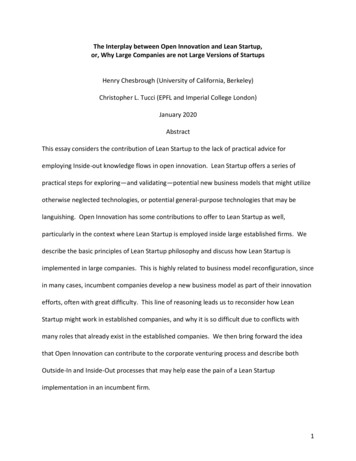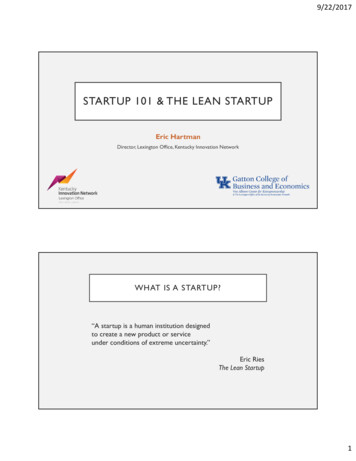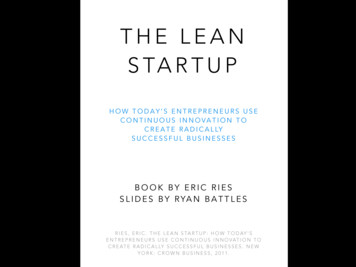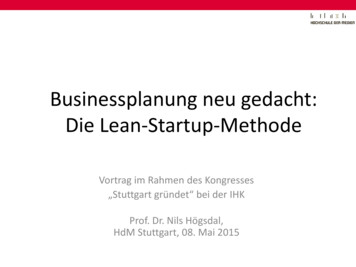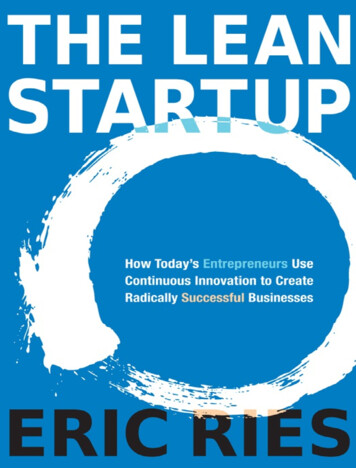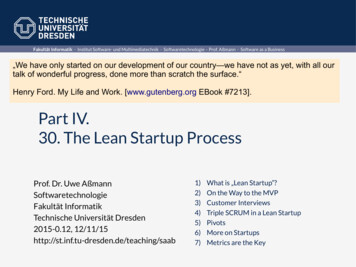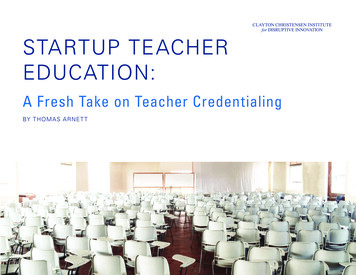
Transcription
CLAYTON CHRISTENSEN INSTITUTEfor DISRUPTIVE INNOVATIONSTARTUP TEACHEREDUCATION:A Fresh Take on Teacher CredentialingBY THOMAS ARNET T
EXECUTIVE SUMMARYAs education reformers across the country are working to improve student outcomes at scale,many are focusing on improving the teaching force. This case study describes how threegroups of charter management organizations—High Tech High in San Diego; UncommonSchools, KIPP, and Achievement First in New York; and Match Education in Boston—createdtheir own teacher certification and master’s degree programs after concluding that theteachers who graduate from most traditional teacher education programs lack the skillsneeded to teach successfully.The greatest common obstacle in creating these programs was navigatingstate policy and accreditation requirements. These requirements varyby state and accreditor and affect the time and effort required for newteacher education programs to be approved. They also heavily influencethe program features an institution must adopt, the start-up costs, andthe cost structure of a program once it is fully implemented. Any newprogram should therefore begin by investigating the requirements specificto its region.In states and regions where the authorization and accreditation processes arelengthy and demanding, program founders need to develop a clear strategyand timeline. They also need to work early to foster strong relationshipswith others in the field who can offer guidance and generate support fortheir work. All programs will likely face some challenges in reconcilinginnovative program models with complex state regulations, which aretypically designed to ensure compliance with traditional approaches.Another common challenge is creating a sustainable business model.Program founders need to articulate a clear understanding of the teachersand schools they are serving, what value new program offerings areproviding, and how to provide this value in a sustainable way. Additionally,new programs need to be thoughtful about how their staffing, facilities,scale, and accreditation status will affect revenues and cost structures.Nontraditional approaches to teacher education—such as sharing resourceswith K–12 schools and adopting innovations in online competency-basedlearning—can help lower operational costs. These features, however, canalso make program approval and accreditation more challenging.By tracing the development of these programs, this case study exploresthe benefits and challenges that schools face when creating their ownteacher certification and master’s degree programs. The study also providesrecommendations for schools looking to launch similar programs.The largest common obstaclefor these programs wasnavigating state policy andaccreditation requirements.C L AY T O N C H R I S T E N S E N I N S T I T U T E : S TA R T U P T E A C H E R E D U C AT I O N2
INTRODUCTIONIn 2000, Larry Rosenstock, the founder and CEO of High Tech High, aSan Diego-based charter management organization (CMO), found himselfconfronting a major hiring problem. He was working to launch the first HighTech High charter school and had determined that many of the teachersshould be industry experts, such as PhD-level engineers and accomplishedartists. This nontraditional approach to staffing was key to the school’sdesign, as Rosenstock planned to center the school’s curriculum on projectswith real-world relevance. But before the school opened, a new state law tookeffect requiring charter schools to hire credentialed teachers.1 In effect, thelaw would prevent him from hiring the types of teachers he wanted to staffhis school. If High Tech High were to succeed, he would have to find a way toreconcile state regulations with his innovative school model.Rosenstock’s challenge is not unique. One of the purposes of the charter school movement is togive schools freedom so that they can experiment and develop new approaches to teaching andlearning. But although many charter schools have successfully developed their own philosophies,pedagogies, and forms of governance, some have found it difficult to find teachers to hire whosephilosophies and methods are aligned with theirs.In response to this problem, a handful of CMOs have created their own programs for educatingteachers, granting teacher certifications, and awarding master’s degrees in education that arecurrently separate from programs at traditional colleges and universities. This case study describeshow three groups of CMOs—High Tech High in San Diego; Uncommon Schools, KIPP, andAchievement First in New York; and Match Education in Boston—worked through regulatoryhurdles and business model challenges to create their own teacher education programs.The three graduate schools provide practical, skillsbased training that integrates formal instructionwith school- and classroom-based experience.C L AY T O N C H R I S T E N S E N I N S T I T U T E : S TA R T U P T E A C H E R E D U C AT I O N3
HIGH TECH HIGHIntern ProgramInduction ProgramMEd ProgramYear founded200420072007Reason for starting programProvide newly hired teachers apathway toward a PreliminaryCredential aligned with High TechHigh’s methods and philosophyProvide teachers an Inductionprogram to obtain a ProfessionalClear Credential aligned withHigh Tech High’s methods andphilosophyTarget studentsTeachers who enter theprofession without firstcompleting a teacher preparationprogramTeachers with PreliminaryCredentials who need renewableProfessional Clear CredentialsEducators with at least 3 yearsexperience who want to deepentheir teaching practices anddevelop their leadership skillsDegree offeredNoneNoneMaster of Education TeacherLeadership or School LeadershipConcentrationTeacher certificationofferedPreliminary CredentialProfessional Clear CredentialNoneStudent Enrollment 65 125 25Tuition 5,000 for two-year program 3,000 for one-year program; 4,000 for two-year program 25,000 for one-year full-time ortwo-year part-time programProgram focusHelp teachers meet certificationrequirementsHelp teachers meet certificationrequirementsTrain experienced teachers onreflective teaching practices andeducational leadershipProgram structureTwo years of coursework,mentorship, and observationwhile teaching full timeOne to two years of professionaldevelopment and mentorshipwhile teaching full timeOne to two years of courseworkwhile employed in an educationalsettingPerformance-basedgraduation requirementTeachers must pass a TeachingPerformance Assessment asrequired by the state of CaliforniaTeachers must demonstratelearning through a final project orpresentationEducators must complete projectsthat demonstrate mastery ofprogram-learning outcomesAccreditation statusAccredited by the CTCAccredited by the CTCCandidate by institutionalaccreditation from WASCImprove the teaching andleadership practices of experienced educators; developinnovative practices to informteacher education reform; prepareand develop school leaders
High Tech High BackgroundAs Larry Rosenstock approached the launch of High Tech High, there did not appear to be a way to hire thenontraditional teachers he wanted and still meet California’s new teacher credentialing requirements. Theindustry experts he had planned to hire to teach the school’s project-based curriculum were already taking paycuts to go into teaching. Asking them to take a year off from employment to complete a traditional teachereducation program would be too great a hurdle to make the career switch worthwhile. On the other hand,California’s education code allowed new teachers to earn credentials through university- or college-basedalternative teacher certification programs that they could complete while teaching full time. 2 But none of theavailable programs aligned with High Tech High’s educational philosophies and project-based curriculum.Rosenstock believed that sending his teachers to one of these programs would be unproductive in meetinghis goals.As Rosenstock wrestled with the issue, he learned of a 1983 California lawthat allowed school districts, CMOs, and county offices of education toseek approval from the California Commission on Teacher Credentialing(CTC) to operate their own alternative teacher certification programs,called District Intern programs, for non-credentialed individuals whoalready possessed bachelor’s degrees.3 Through these District Internprograms, participants could earn a Preliminary Credential by completingcoursework and mentorship experiences while employed as full-timeteachers on a District Intern Credential.4Although Rosenstock could not avoid the state requirement to staff hisschool with credentialed teachers, he could offer an alternative route toteacher certification by creating a District Intern program. Such a programwould need to align with California’s teacher credentialing requirementsand provide new teachers with adequate preparation to teach in any ofCalifornia’s K–12 schools. But within those requirements, Rosenstockcould create a program that would align closely with High Tech High’slogistical needs and pedagogical approaches.5First-tier teachercredentialingSetting up the District Intern program proved to be a lengthy and involvedprocess. The CTC holds District Intern programs to the same standardsas teacher education programs offered by universities or colleges. To meetthe CTC requirements, High Tech High first had to develop a sequenceof teacher preparation courses. Then, it had to train staff members whoalready had teaching credentials and prior teaching experience in methodsfor training new teachers. Finally, it had to develop processes and systemsfor administering the program.High Tech High also had to find creative ways to satisfy some of the CTCrequirements while remaining true to its vision for teacher education. Forexample, High Tech High’s leaders had developed their own language fordescribing the elements of their school model. But in order to meet theapplication requirements, they had to re-craft their language to make it fitthe language and framing of the CTC standards.C L AY T O N C H R I S T E N S E N I N S T I T U T E : S TA R T U P T E A C H E R E D U C AT I O N5
The CTC rejected High Tech High’s application multiple times before finally approving theCMO’s proposed District Intern program in August 2004.6 When High Tech High’s programlaunched that fall, it was the first District Intern program in the state to be sponsored by acharter school. Initially, the CTC authorized High Tech High to offer only Single SubjectTeaching Credentials for secondary teaching.7 In the years that followed, High Tech High’sleaders completed the program approval process two more times so that the District Internprogram could also offer Multiple Subject Teaching Credentials for elementary teaching startingin Fall 20098 and Education Specialist Instruction Credentials for special education teachersstarting in Fall 2011.9In 2008, the CMO opened the High Tech High Intern program to teachers from non-High TechHigh schools. Today, High Tech High’s program is one of only eight approved District Internprograms in California.10 It serves roughly 65 teachers each year, with about two thirds of thoseteachers teaching at High Tech High schools and the rest teaching at other public and privateschools in the San Diego area.Until 2013, the state had provided High Tech High with line-item funding to support the HighTech High Intern program. This line-item funding, which covered the majority of the program’soperating expenses, enabled the CMO to offer the High Tech High Intern program free ofcharge to both High Tech High and non-High Tech High teachers. Under California’s 2013revisions to the Local Control Funding Formula, however, the state no longer provides line-itemfunding to District Intern programs.11 With this change in the state funding policy, High TechHigh began charging both High Tech High and non-High Tech High teachers 2,500 a year eachto participate in the two-year High Tech High Intern program starting in Fall 2014.High Tech High2000Founded2000 Begins creating District Internprogram to provide Californiafirst-tier credentials2004 The CTC approves DistrictIntern program2006 Begins creating Inductionprogram to provide Californiasecond-tier credentials2007The CTC approves Inductionprogram2007 State approves new graduateschoolInstitutional accreditation can be importantfor establishing credibility and giving studentsaccess to federal financial aid, but pursuing it is alengthy and expensive process that influences theorganization’s capabilities and business model.2007 Graduate school begins processfor regional accreditation2012Graduate school namedcandidate for regionalaccreditation2015Graduate school receivesregional accreditation(expected)C L AY T O N C H R I S T E N S E N I N S T I T U T E : S TA R T U P T E A C H E R E D U C AT I O N6
Second-tier teachercredentialingWith the High Tech High Intern program underway, High Tech High’sleaders were ready to tackle a second challenge related to teacher certification.The High Tech High Intern program allowed the school’s non-credentialedteachers to earn a Preliminary Credential—but the Preliminary Credential,which is only valid for five years and is not renewable, is only the first tierin California’s two-tier credentialing system.12 During the first five yearsof teaching, teachers are expected to earn a Professional Clear Credentialthrough an approved Teacher Induction program sponsored by a schooldistrict, county office of education, college or university, consortium, orprivate school.13 The purpose of the state’s Teacher Induction requirementis to help novice teachers apply the knowledge and skills they learned intheir teacher education programs to their classroom teaching practices byproviding them with individualized support and assistance, collaborativeexperiences with colleagues, and frequent feedback on their teaching.14For High Tech High’s leaders, setting up the High Tech High Inductionprogram was simpler than creating the High Tech High Intern programbecause the state had intended for Teacher Induction programs to beoffered primarily through K–12 school systems. Unlike District Internprograms, which require coursework and learning experiences similar tothose found in university- or college-based teacher education programs,Teacher Induction programs focus on professional learning experiences atthe school site and within the school community.Nevertheless, it took High Tech High two years to complete the CTC’sprogram approval process. The CTC requires Teacher Induction programsto have a formative assessment system in place for their teachers, andHigh Tech High’s leaders initially designed their own system. When thatsystem did not receive CTC approval, High Tech High partnered with NewTeacher Center, a nonprofit organization focused on improving teachereducation, to develop a formative assessment system that would hopefullymeet CTC standards. But even after High Tech High worked with NewTeacher Center to revise its formative assessment system, the CTC againdetermined that the formative assessment system did not meet CTCstandards. After multiple revisions to the system, the CTC finally approvedHigh Tech High’s proposed Teacher Induction program in October 2007.15Today, the High Tech High Induction program serves roughly 125 teachersa year, with about half of those teachers teaching at school districts orother charter schools in the San Diego area.16 High Tech High providesthe Induction program at no cost to its own teachers. Teachers from otherschools pay 4,000 for the two-year program or 3,000 if their teachingexperience qualifies them to complete the program in one year. Non-HighTech High teachers pay an additional 1,000 if they need High Tech Highto provide them with a mentor during the program.Creating a graduate schoolof educationIn 2004, High Tech High’s leaders started thinking about how they couldincrease High Tech High’s impact on the national education reformlandscape. With this goal in mind, they began considering what it wouldtake to create a master’s degree program in which teacher and schoolleaders could explore progressive pedagogies, look critically at differentapproaches to teaching and leadership, and most importantly, apply theirlearning directly to their work in schools and classrooms. Expanding inthis new direction seemed like a natural extension of the school’s existingwork in teacher education and professional development. As Rob Riordan,who became the president of the High Tech High Graduate School ofEducation, said, “We knew when we started High Tech High that if it wasgoing to be a rich learning environment for kids, it would have to be a richlearning environment for adults.”Philanthropists and thought leaders from the broader education reformcommunity were also interested in efforts to reform teacher education,and this national interest helped High Tech High secure support andfunding to start a new graduate school of education. “The [High Tech HighGraduate School of Education] has attracted more interest from fundersthan anything else we’ve done, partly because of all the press around thecrisis in teacher education and the disconnect between schools of educationand the K–12 schools,” said Riodian.Luckily for High Tech High, California’s requirements for establishingan institution of higher education were minimal and the applicationprocess was relatively quick and straightforward.17 In 2007, High TechC L AY T O N C H R I S T E N S E N I N S T I T U T E : S TA R T U P T E A C H E R E D U C AT I O N7
High submitted an application to establish the High Tech High GraduateSchool of Education (GSE) and received state approval shortly thereafterfrom California’s Bureau of Private Postsecondary Education.18 High TechHigh launched the GSE in the fall of that same year with two programs: aMaster of Education in Teacher Leadership and a Master of Education inSchool Leadership.Gaining accreditationWith the graduate school up and running, High Tech High’s leadersimmediately turned their attention toward seeking regional accreditationfor the GSE through the Western Association of Schools and Colleges(WASC). They knew that gaining accreditation would be critical to theGSE’s success for three reasons. First, K–12 educators often earn master’sdegrees to qualify for salary increases at their employing schools, but themajority of K–12 schools do not recognize degrees earned at unaccreditedinstitutions. Secondly, other institutions where the GSE’s alumni mightseek further education may not recognize coursework and degrees froman unaccredited institution. (The GSE did, however, work out agreementswith local universities to honor the GSE’s degree while the school was inthe process of being accredited.) Finally, without accreditation, the GSE’sstudents would not be eligible for Title IV federal student financial aid.Even though the GSE had few problems obtaining state approval, it hasfaced numerous challenges and setbacks while trying to gain regionalaccreditation.19 Shortly after the GSE’s leaders submitted their application foraccreditation, WASC’s Accreditation Commission for Senior Colleges andUniversities (Accreditation Commission) determined that the school waseligible to seek accreditation and scheduled initial site visits. But followingvisits in 2009 and 2011, the Accreditation Commission determined that theGSE did not meet the minimal compliance requirements for accreditationcandidacy. Accordingly, the Accreditation Commission identified areaswhere the school needed improvement in order to meet accreditationstandards and scheduled a special visit for Spring 2012.20After the 2012 visit, the Accreditation Commission designated the GSEas a candidate for accreditation and scheduled additional visits in 2013and 2015. During these visits, it identified additional areas where the GSEstill needed to meet the accreditation standards, including increasing thenumber of required credit hours; improving the rigor of the assignmentsincluded in the coursework; expanding the size and diversity of the Boardof Trustees; developing more formal governance procedures; “codifyingthe practices of scholarship and creativity” appropriate to the culture ofa “graduate education enterprise;” and developing and implementing “aprocess for the continual implementation and recalibration of [the GSE’s]strategic plan.”21 The GSE’s leaders worked to address these issues inpreparation for their visit from the Accreditation Commission in March2015. If the forthcoming report from the Accreditation Commission’s visitis favorable, the GSE should receive full regional accreditation in June2015. If the GSE receives accreditation in 2015, the accreditation processwill have taken more than eight years to complete.Business modelIn addition to the challenges of accreditation, High Tech High’s leadershave struggled to solidify a sustainable business model for the GSE. Theschool advertises the total tuition for the two-year master’s degree programat 25,000,22 but High Tech High subsidizes the tuition costs for manyof its degree candidates through generous fellowships, in part becausestudents were ineligible to receive Title IV federal student financial aiduntil the GSE became a candidate for accreditation in 2012. The GSEtypically brings in around 100,000 each year in revenue from tuition,23but this revenue covers only a small portion of the roughly 1,000,000 theGSE spends annually on salaries, benefits, and other operational expenses.Additionally, it brings in roughly 700,000 per year from fees for workshops,consulting services to other K–12 schools, and school tours.24 The GSE alsoreceives additional support from private philanthropies, which give varyingamounts from year to year. Furthermore, while awaiting accreditation,High Tech High has had to rely on a reserve fund it created at the start ofthe WASC accreditation process to cover the GSE’s remaining deficit.The expenses associated with the accreditation process have placed anadditional strain on the GSE’s finances. For example, High Tech High hashad to take on additional costs associated with separating the operationsof the GSE and the K–12 schools to satisfy governance requirements foraccreditation. It has also had to hire additional staff to work exclusively onaccreditation and has spent roughly 20,000 hosting external evaluators.C L AY T O N C H R I S T E N S E N I N S T I T U T E : S TA R T U P T E A C H E R E D U C AT I O N8
Next stepsHigh Tech High’s leaders are actively considering new approaches for achieving their desiredimpact. Starting in Fall 2014, the GSE consolidated its two Master of Education Programsinto a single program that offers two concentrations: the Teacher Leadership concentrationand the School Leadership concentration. Consolidating the programs has simplified theaccreditation process because the GSE now has to obtain accreditation for only one program.It has also lowered the GSE’s operating expenses because the school now employs only onedirector to run the single program.Once the GSE gains regional accreditation, High Tech High is considering developing a oneyear, full-time teacher education program.25 Students would earn a Preliminary Credentialand a master’s degree at the GSE and then complete their student-teaching requirement atone of the 13 High Tech High charter schools. Such a program would provide prospectiveteachers with a year of training before taking on full-time teaching responsibilities.26The GSE is experimenting with ways to provide educator training through means other thandegree programs. During the 2014–15 school year, it is piloting an Education LeadershipAcademy in which teams of school and teacher leaders from schools across the world visit HighTech High three times throughout the year for three days at a time to observe the High TechHigh charter schools, attend workshops on teaching methods and school leadership, interactwith High Tech High teachers and GSE faculty, and learn from each other. In addition to thevisits, High Tech High helps attendees initiate projects that they will implement back at theirown schools and arranges collaborative partnerships between attendees who share similargoals and interests. These partnerships, referred to as “critical friends,” are set up as a virtualcommunity, and they provide attendees with sources of collaboration and feedback as theyimplement their projects.27In 2013, the GSE began offering massive online open courses (MOOCs) as a way to share HighTech High’s practices with a global audience, as well as with educators who are interested inlearning more about High Tech High’s programs and practices but are unable to travel to SanDiego for the workshops. High Tech High’s leaders view these courses as experiments in newmodes of teaching and learning, as well as a marketing tool for generating greater interest intheir on-campus programs. As part of their strategic plan, the GSE’s leaders are exploring theviability of creating a blended-learning degree option and are using the MOOCs to deepentheir understanding of how to create a successful blended-learning experience for school andteacher leaders.C L AY T O N C H R I S T E N S E N I N S T I T U T E : S TA R T U P T E A C H E R E D U C AT I O N9
RELAY GRADUATE SCHOOL OF EDUCATIONMAT ProgramRelay Teaching Residency ProgramYear founded20112014Reason for starting programCreate a pipeline for supplying district andcharter schools serving low-income studentpopulations with effective new teachersProvide aspiring teachers with an onrampinto the profession that allows them todevelop critical skills before taking on fullresponsibility for a classroomTarget studentsNovice teachers who hold full-timeteaching positionsAspiring teachersDegree offeredMaster of Arts in Teaching (MAT)Master of Arts in Teaching (MAT)Teacher certification offeredInitial or Professional CertificateInitial or Professional CertificateStudent enrollment 980 teachers 120 aspiring teachersTuition 17,500 for two-year program* 17,500 for two-year program*Program focusTrain teachers in concrete teaching skills that directly impact student learning and providethem a path to professional licensureProgram structureTwo years of competency-based learning,both online and face-to-face, while teachingfull timePerformance-based graduationrequirementDuring Year 2, teachers must demonstrate that their students’ achieved at least one year ofacademic growth using a variety of quantitative and qualitative measuresAccreditation statusInstitutional accreditation by MSCHE; accreditation as a teacher education program by NCATETwo years of competency-based learning,both online and face-to-face, while working ina school-based position under the guidanceof a Resident Advisor during Year 1 and as afull-time teacher during Year 2*The listed tuition for Relay’s two-year MAT program is 35,000, but all students are eligible to receive the Urban Teacher Scholarship, which reduces tuition to 17,500 for two years.
Relay Graduate School of Education BackgroundIn 2006, Norman Atkins, the founder of Uncommon Schools, a CMO that operates in New York, New Jersey,and Massachusetts, and David Levin, a co-founder of KIPP (Knowledge is Power Program), the nation’slargest network of charter schools, with 82 schools in 19 states and Washington, D.C., were earning nationalrecognition for their charter schools, which were helping to close the achievement gap for thousands ofstudents from low-income backgrounds. But Atkins and Levin were not satisfied. More than 12 million childrenwere living in poverty in the United States and a high percentage of them were attending sub-standardschools. 28 Atkins and Levin were concerned that their organizations were not scaling fast enough to addressproblems of educational inequity in a substantial way. As they considered how to increase their impact, theyconcluded that they needed to find a way to share the techniques and systems they had developed in theirschools with the broader field.At the same time that they were conceptualizinghow to broaden their impact, Atkins and Levinnoticed a practical challenge that many of theteachers in their New York schools faced. NewYork requires teachers to complete an educationfocused master’s degree in order to obtain aProfessional Certificate, which is the secondlevel teaching certificate in New York’s teachercredentialing system.29 Teachers often reported,however, that their master’s degree programswere time-intensive, costly, and not aligned withthe practices and training in their schools.To address these problems, Atkins and Levin,in partnership with Dacia Toll, the founderand co-CEO of Achievement First, a CMO thatoperates in Connecticut, New York, and RhodeIsland, decided to create a new teacher educationprogram. Their aim was to develop a programthat would meet New York’s state educationrequirements for teacher credentialing in a waythat would better address the professional andpractical needs of early-career teachers.Creating a new teacher educationprogramAs they started exploring options for creating a new teacher education program, the charter schoolleaders found that launching a new institution of higher education was no easy task. In New York,new schools of education must meet rigorous standards and go through a lengthy approval processto receive state authorization to enroll students and issue degrees.30 Rather than wrestling with thechallenges of obtaining state approval while trying to build a new program from the ground up,Atkins, Levin, and Toll decided to partner with an existing institution of higher education.They found the partner they were looking for in David Steiner, the then dean of the Hunter CollegeSchool of Education.31 Steiner, also a critic of traditional teacher preparation, was eager to work withthe three charter school operators to create
CLAYTON CHRISTENSEN INSTITUTE: STARTUP TEACHER EDUCATION 6. Second-tier teacher credentialing With the High Tech High Intern program underway, High Tech High’s eladers were ready to tacke a sl econd chalelnge related to teacher certifciatoi n. High Tech . s
